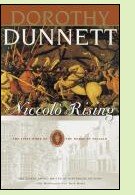|
Niccolo Risingby Dorothy DunnettReviewed by Margaret Donsbach Exasperating, because this is an extraordinarily complex novel requiring brainpower and conscious attention to detail if reader is to keep up with author. One of the few concessions Dunnett offers to reader frailty is a list of over 100 primary and secondary characters, briefly described, with asterisks showing which are historical. The novel sometimes feels like a Bruegel painting, crammed with exuberant crowds in which each face is expertly and individually limned. Wonderful, because if the reader manages to (mostly) keep up, Dunnett takes us on a breathlessly exciting adventure as her protagonist, a likeable bastard named Claes, charms and schemes his way out of one death-defying scrape after another. The novel is full of delicious twists and turns, and nothing is as simple as it first appears to be. The humor is sometimes broad, more often ironic and sly. The setting is richly textured with details that bring fifteenth century Bruges brilliantly to life: the dye-workers' stained fingers and stinking aprons, a lady's high-peaked hennin headdress that comes unglued after it falls into a canal, the prized hunting hounds of the aristocrats and the savage street dogs that require city-funded "hondeslager" patrols to club them into submission. Claes is an apprentice for the cloth-dying firm run by the widowed Marian de Charetty. Felix is the widow's spirited teenage son, not quite smart enough to learn the task of steering the business he will inherit. Julius is the widow's clerk, young enough to join in the milder of the boys' pranks, old enough to accept the mantle of responsibility. Who is Niccolo? To tell would spoil the surprise. Readers who persist (many will not) through the the first half of Niccolo Rising will find the second half munificently rewards their efforts. It would be hard to reach the end without wanting to continue to the other novels in the series. (1986, 470 pages) More about Niccolo Rising from Powell's Books
For a guide to Dunnett's novels and their historical backgrounds, see The Dorothy Dunnett Companion, Volumes I and II, by Elspeth Morrison. Niccolo Rising is covered in Volume I.
The Lady and the Unicorn by Tracy Chevalier (2003), about the creation of the Lady and the Unicorn tapestries. More info The Last Queen by C.W. Gortner (2008), about Juana of Spain, who married Archduke Philip of Flanders in 1496. More info I, Jacqueline by Hilda Lewis (1957), about Jacqueline of Hainault, a Flemish countess whose real life was full of twists and turns and hair-raising adventures, set in the fifteenth century a few decades before Niccolò Rising (new edition forthcoming in October 2008) As Above, So Below by Rudy Rucker (2002), about the sixteenth century Flemish artist Peter Bruegel. More info
Flanders: A Cultural History by André DeVries (2007). More info Medieval Flanders by David Nicholas (1992). More info from Amazon.com |
 Niccolo Rising is an exasperating, wonderful novel set in the wealthy Flemish cloth-manufacturing city of Bruges in the mid-fifteenth century.
Niccolo Rising is an exasperating, wonderful novel set in the wealthy Flemish cloth-manufacturing city of Bruges in the mid-fifteenth century.